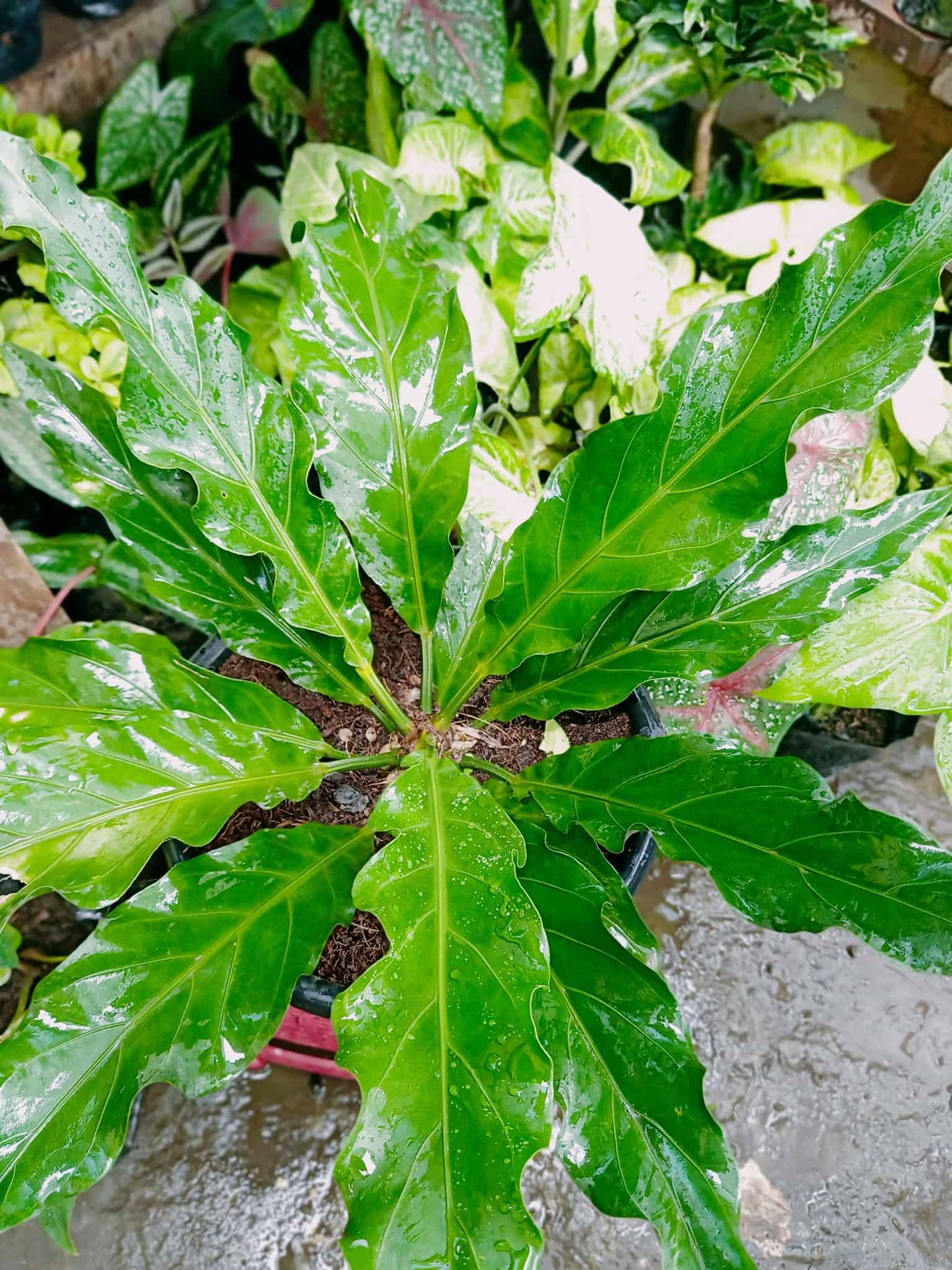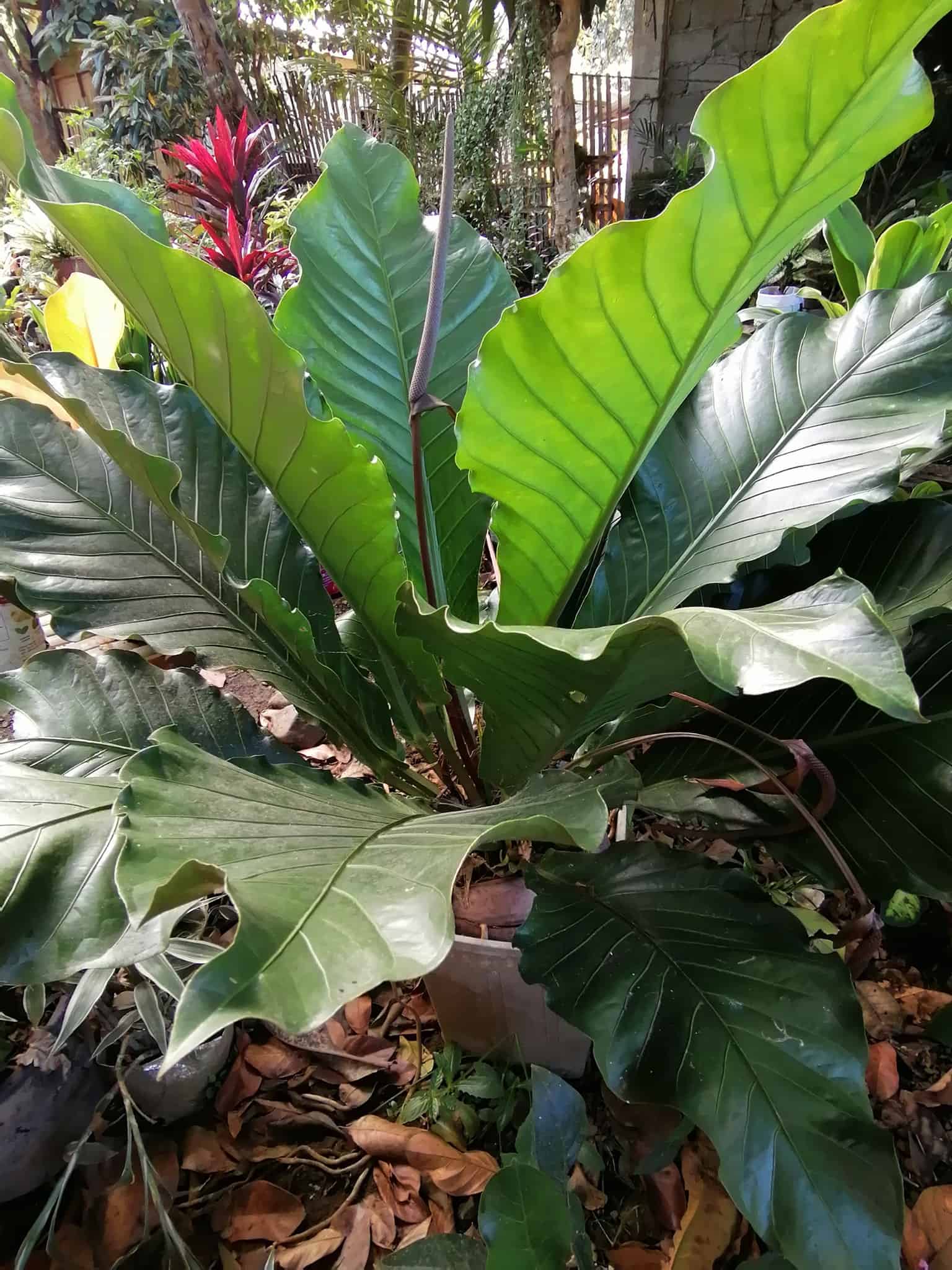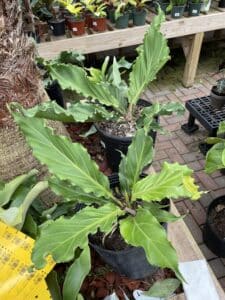The wavy and glossy Anthurium Plowmanii leaves invoke tropical vibes in any indoor setting, but without correct fostering, the plant can slowly drop its lush gleam.
With the proper care and attention, you can have Plowmanii thriving in your living space, aiding the beauty of your home. So, stand by and follow the article.
Table of Contents Show
Overview of Anthurium Plowmanii
Did you know Anthurium Plowmanii was named after the botanist Timothy Plowman? It’s no wonder that they both have almost the same-sounding surnames!
But, it was initially introduced in 1872 by James Veitch & Sons, who found a specimen while traveling to the rainforests of Costa Rica.

The ruffled and flaring leaves of Anthurium Plowmanii are noticeable from a distance, leading to its discovery, but some other prominent features make it a truly unique plant.
| Features | Descriptions |
|---|---|
| Scientific Name | Anthurium plowmanii |
| Common Name | Bird's Nest Anthurium, Anthurium Wave of Love, Wave of Love, Anthurium Plowmanii 'Ruffles,' and Anthurium Plowmanii 'Fruffles' |
| Family | Araceae |
| Status and Ecology | Life Cycle: Evergreen Perennial Habit: Epiphytic, Epilithic, or Lithophytic Herbaceous Shrub Habitat: Tropical Rainforests Native Range: Peru, Western Brazil, Paraguay, and Bolivia USDA Zones: 10b to 11 |
| Growth Rate | Slow to Moderate |
| Plant Size (Height and Spread) | 1.5 to 2 meters × 1.5 to 2 meters |
| Growing Season | Spring and Summer |
| Leaf | Shape: Obovate to Oblanceolate (Round-Lance Shaped) Size: 1.5 to 2 meters long Color: Dark Green Texture: Glossy |
| Flowering Season | Summer |
| Flower | Inflorescence: Spathe and Spadix Color: Violet Purple or Green Tinged with Purple Spathe and Green to Dull Maroon to Green Tinged with Violet to Violet-Purple Spadix Shape: Leafy Spathe and Cylindrical Spadix |
| Grown for | Long Leaves with Undulating Margins |
| Toxicity | Toxic to Pets and Humans |
Anthurium Plowmanii on Sale
Propagation is the cost-effective option to grow more Anthurium Plowmanii.
However, store-bought plants come in handy planters, and you can offer early care for them.
| Shops | Delivery |
|---|---|
| Etsy | Within 20-30 days after placing an order |
| Amazon | Within 4-5 days after placing an order |
| Mickey Hargitay Plants | Within 1-3 days after placing an order |
| Gabriella Plants | Within 7 days after placing an order |
Anthurium Plowmanii: Ultimate Grow & Care Guide
For healthy growth of the leaves, Anthurium Plowmanii requires prime tropical care.
Anthurium Plowmanii grows naturally under the shade of tall trees. So, try to replicate similar indoor conditions.
Let’s see some care needs for Anthurium Plowmanii.
1. Light and Temperature
With the increase in light intensity, there is a sudden surge in temperature, while lowering the light intensity can decrease it.
Besides, the plant exhibits certain stressful signs if the temperature and light care are irregular.
Extreme Light and Temperature: Fading leaf color to yellow and then brown, curling of leaves, with brown tips and margins.
Low Light and Temperature: Progressive discoloration of leaves from yellow to brown, leaf fallout, stunting growth, fewer flowers and leaves.
To relieve the plant from light and temperature issues, you can follow these given tips.
- Keep the plant away from north-facing windows in fall and winter, radiators, and cooling vents.
- Locate the plant near east-facing windows or 3-5 feet away from south-facing windows in spring and summer.
- Regularly monitor the temperature changes using indoor thermometers.
- Shade the plant from the extreme summer heat and use frost blankets for outdoor plants in winter.

2. Watering and Humidity
Anthurium Plowmanii demands moist soil with high ambient humidity.

Overwatering and Underwatering can take a toll on the leaves of Anthurium Plowmanii, ultimately killing the plant.
Although Anthurium Plowmanii is tolerant to high humidity, declining humidity levels can severely affect its growth.
Underwatering Symptoms: Dwindling leaf color from green to brown, resulting in crispy, wrinkled leaves.
Overwatering Symptoms: Changing leaf color from green to brown, ensuing limpy leaves due to root rot.
Effect of Low Humidity: Leaf fall, slow growth, and formation of small-sized leaves.
If you want to save Anthurium Plowmanii from watering and humidity outturns, follow these recovery steps.
- Check the topsoil for dryness before watering using a finger-dip test.
- Unpot the plant and check for signs of root rot.
- Place the plant on a pebble tray with an inch of water to offer humidity for the leaves.
- Promote early morning watering so the soil remains saturated for the entire day.
3. Soil and Fertilizer
The proper soil for Anthurium Plowmanii must contain well-draining and water-holding elements and enough nutrients (mainly NPK) for continuous growth.
Over time, the soil may gradually lose nutriment, making the plant nutrient deficient. However, too much nutrient in the soil may harm the leaves and hinder nutrient uptake.
Similarly, heavy soil can cause water logging issues and injure the roots.
Lack of Proper Soil: Root rot due to puddling of stagnant water on the topsoil causing less oxygen to reach the roots.
Symptoms of Excessive Fertilizer: Accumulation of fertilizer salts on the topsoil resulting in brown tips and margins of leaves (fertilizer burn).
Symptoms of Limited Fertilizer: Change in the color of leaves, stunted growth, declining root growth and fewer blooms.

But you can follow these tips to save your plant from the consequences of using the wrong soil and improper fertilization.
- For soggy conditions, poke holes using chopsticks in the topsoil to promote aeration.
- Unplug the drainage holes of the planter to drain the excess water.
- Place the potted plant in full sun to dry out the soil.
- Add organic perlite or sand to increase the soil drainage.
- If the soil gives off a foul or fishy smell, unpot the plant and repot in fresh potting mix.
- To wash out the fertilizer salts, flush the soil 4-5 times with distillate water.
- Apply one-fourth strength of the total fertilizer concentration to prevent fertilizer burns.
4. Biennial Repotting
You must repot Anthurium Plowmanii when it gets root bound inside its old pot.
The slow growth rate of Anthurium Plowmanii makes it a laidback houseplant in case of repotting, but there are signs shown by the plant when it needs wider legroom.
Symptoms of Root Bounding: Roots protrude from the drainage holes of the pot, cramming roots on the topsoil and delaying growth.
As soon as the symptoms are visible, proffer a new home to your Anthurium Plowmanii.
- Water your plant 1-2 days before repotting to make the soil loose.
- Take out all the soil and free the roots from the root ball.
- Take a new pot and fill it one-third with a new potting mix.
- Place the plant in the soil by spreading its roots.
- Cover the plant’s roots with more soil and fill the soil up to 0.5-1 inch below the pot’s rim.
- Water the topsoil gently and give the plant a few weeks to recover after placing it in a shady spot.
5. Frequent Pruning
Pruning is crucial to reduce the number of injured or decaying foliage and assist the plant in saving its energy for the next set of leaves.
Timely trimming also helps to monitor for pests (aphids, mealybugs, spider mites, scales, and gnats) and diseases (leaf spots, blights, and root rots).
Symptoms for Pest Infestation: Honeydews on the lower surface of the leaves, wilting of the leaf surface, and gradual yellowing and browning of the leaves.
Symptoms for Disease Outbreaks: Yellow or brown leaves on the leaf surface, water-soaked lesions on the leaf margins that burst open and turn brown, and a foul smell from the soil due to root decay.
To protect Anthurium Plowmanii from pests and diseases, mind these tips below.
- Isolate the plant from other houseplants to prevent the infection from spreading.
- Cast away the pests or honeydew using q-tips laced with isopropyl alcohol.
- Kill the pests or deter diseases by spraying neem oil once a week.
- Cut the infected plant parts and burn them for safe disposal.
- For root rots, change the soil and repot the plant in a sterilized potting mix.
Growth Rate of Anthurium Plowmanii
Anthurium Plowmanii is a large epiphytic, tropical plant growing up to a height of 1.5-2 meters with a similar spread.
The leaves of the plant have wavy or undulated margins. For this trait, the plant is also commonly named “Wave of Love.”
At homecare, the plant may refrain from reaching this height and spread. So, environmental factors play a crucial role in the plant’s growth, especially humidity, light, water, and temperature.

With proper watch out, the plant grows new foliage every year from early spring to late summer.
However, the plant may slow down in winter and enter dormancy. But, before entering the dormant phase, the plant adorns flowers for a few months.
Moreover, the blooms or inflorescence are called Spathe and Spadix, a characteristic of aroids.
The spathe is a leafy and reflexed structure that is green-purplish or violet-purplish in color. A maroon-greenish or violet to violet-purplish, cylindrical and tapering spadix emerges from the top of a flowering stalk.
Additionally, the spathe helps to lure pollinators, while the spadix bears many tiny flowers that aid seed production.
Toxicity of Anthurium Plowmanii
According to ASPCA, all Anthurium varieties are toxic to pets and humans.
If your pets munch the plant parts, they exhibit oral irritation, swelling of the tongue, intestinal tract, and throat, breathing difficulties, nausea, and hoarse sounds.
Besides, humans may show similar symptoms upon ingestion, but the sap from the plant parts may cause skin irritation, rashes, and swelling on contact.
So, it’s best to keep the pets and children away from the plant or relocate it away from them indoors.
If curious pets or children somehow happen to nibble or touch the plant and show the above signs, contact any of the helpline numbers to report an emergency case.
Propagation Methods for Anthurium Plowmanii
You can propagate Anthurium Plowmanii through leaf cuttings, root division, and seeds.
However, leaf cuttings and root division are the most reliable and express propagation methods.

1. Propagation Via Leaf Cuttings
To enjoy high success in propagation, take the cuttings in spring when the plant sprouts new growth.
First, propagate in water and later in the soil after the cuttings grow new roots.
- Select the healthy bottom leaves and cut them with sterilized shears at the base where the petiole joins the node of the main stem.
- Place the cuttings in a glass jar with rooting hormone solution and keep them in bright but indirect sunlight for 6-8 hours.
- Use one jar per cutting and prevent overcrowding.
- Keep a humidifier near the cuttings set at 50-80% and cover them with a plastic bag.
- Change the water every 3-5 days.
- Within 2-4 weeks, the cuttings will have 1-2 inches long roots.
- Transplant the cuttings in a fresh potting mix about 1-2 inches deep.
- Monitor regularly, and start to fertilize the plant after new growth emerges.
2. Propagation Via Root Division
Roots of mature Anthurium Plowmanii tangle up that can be divided into separate plantlets and planted in the soil in spring.
- Water your plant 1-2 days before for easy pull.
- Turn the pot upside down and tap at the base of the pot. The plant should slide out with the intact root ball.
- Separate the root system gently until the thick central root is visible.
- Cut the thick root vertically from the center and separate them from the tangled roots.
- Take 2-3 divisions with healthy leaves. Also, prune the diseased leaves using sterilized shears.

- Fill the new pot with the potting soil and place the divisions in the center. Remember to place only one division per pot.
- Add more soil until the topsoil’s surface remains an inch below the pot’s rim.
- Locate the cuttings in a spot where they can receive bright indirect light and water after 1-2 inches of topsoil become dry.
- Give some time for the divisions to pick up growth and then fertilize as necessary.
Check this video to get into the details about propagating Anthurium Plowmanii.
FAQs About Anthurium Plowmanii
Does Anthurium Plowmanii Bloom?
Anthurium Plowmanii bears flowers in summer. They bloom for 3 months and stop blooming in fall and winter.
When spring hits, they start showing signs of flowering again.
Can Anthurium Plowmanii be Propagated in Water?
Anthurium Plowmanii can be propagated in water, but to grow an entire plant, the cuttings (from leaf or stem) must have at least one node.
Is Anthurium Plowmanii Variegated Rare?
Anthurium Plowmanii Variegated is a rare variety of Anthurium Plowmanii with yellow variegations in the leaves.
From Editorial Team
Mimic Tropical Homecare!
Anthurium Plowmanii is a popular Anthurium species with leaves and stature as their trademark. But, the plant’s health can dwindle, and leaves may lose their flare without correct tropical care.


